France’s workforce is undergoing a silent revolution. Over 1.2 million professionals have abandoned traditional employment for self-managed career paths in the last three years. This shift reflects growing demand for flexibility without sacrificing stability – a balance two distinct professional statuses uniquely provide.
Choosing between these deux statuts represents more than paperwork. It shapes your financial security, client relationships, and long-term growth potential. Both options grant complete control over project selection and scheduling, but their approaches to risk management differ dramatically.
One model combines entrepreneurial freedom with employee-like protections, including automatic social coverage. The other offers maximum independence but requires handling taxes and contracts solo. Your ideal choice depends on whether you prioritize structured support or complete administrative autonomy.
Table of Contents
Key Takeaways
- Hybrid work models combine flexibility with traditional employment benefits
- Project selection autonomy remains consistent across both career paths
- Financial security levels vary significantly between the two structures
- Administrative responsibilities differ by 60-80% depending on chosen status
- Long-term career goals should guide your professional framework choice
Overview of the Independent Work Landscape in France
French professionals are rewriting career rulebooks through non-traditional work arrangements. Over 42% of new career transitions now involve self-managed activité models, according to recent DARES studies. This movement reflects deeper changes in how people define professional success.
Autonomy and Flexibility in Modern Careers
Today’s workforce prioritizes control over schedules and project selection. « Choosing my clients lets me balance creative work with family time, » notes a Paris-based marketing consultant. Three key drivers fuel this shift:
- Demand for hybrid models blending independence with stability
- Tech platforms enabling remote collaboration
- Changing employer expectations for specialized skills
Context and Trends for Independent Professionals
Sector growth reveals surprising patterns. While tech dominates, traditional industries like education and healthcare show 18% annual growth in travail indépendant. Consider these sector comparisons:
| Sector | % Independent Workers | Avg. Project Length |
|---|---|---|
| Technology | 34% | 6 months |
| Consulting | 28% | 9 months |
| Creative Arts | 19% | 3 months |
New regulations make independent careers more accessible. Since 2022, simplified registration processes have reduced administrative hurdles by 40%. This framework supports professionnels testing business ideas while maintaining social protections.
Understanding Portage Salarial

France’s professional landscape now offers innovative frameworks for those seeking structured independence. This hybrid model creates a three-way partnership between professionals, clients, and specialized service providers.
Definition and Key Features
The portage salarial system operates through a licensed intermediary. This société portage handles invoicing, tax payments, and social contributions while you focus on delivering services. Key characteristics include:
- Full employee status with standard benefits package
- Direct control over client selection and project terms
- Automatic coverage under France’s social security regime
Eligibility, Advantages, and Limitations
Professionals must meet specific criteria to access this statut. Minimum earnings of €2,517 monthly apply, combining base salary and bonuses. Qualification requirements include either:
- Bac+2 diploma in relevant field
- Three years’ proven sector experience
This model particularly benefits technical consultants and project leaders. Major advantages include built-in unemployment protection and pension accrual. However, management fees (3-15% of income) and activity restrictions apply to certain professions.
Creative directors and healthcare practitioners typically can’t use this framework. For eligible salarié porté professionals, it provides ideal middle ground between corporate safety and entrepreneurial freedom.
Exploring the Freelance Model
The freelance revolution reshapes how professionals engage with work. Over 800,000 French indépendants now operate outside traditional employment frameworks. This model thrives on personal agency – you become both strategist and executor of your career vision.
Core Principles of Independent Work
True freelancing means owning every business decision. « Choosing my projects lets me grow my expertise while maintaining work-life balance, » shares a Lyon-based web developer. Three pillars define this activité:
- Direct control over client negotiations and pricing
- Freedom to combine multiple income streams
- Responsibility for all legal and financial obligations
Choosing Your Business Framework
France offers tailored statuts for different needs. Compare popular structures:
| Structure | Key Benefit | Ideal For |
|---|---|---|
| Micro-Enterprise | Simplified taxes | Low-risk solo ventures |
| Entreprise Individuelle | Asset protection | Growing service providers |
| SASU | Corporate credibility | High-earning specialists |
Seasoned professionals often graduate to société formats as revenues grow. A graphic designer might start with micro-enterprise status, then transition to EURL when hiring assistants. Each framework balances administrative effort with financial upside.
Your entreprise structure impacts client perception and growth potential. Consult legal experts to match your activité scope with optimal fiscal arrangements. The right choice positions you for sustainable success in France’s dynamic independent market.
portage salarial vs freelance: Key Differences

Choosing your professional framework impacts every aspect of your independent career. While both paths offer project selection freedom, their operational realities diverge in three critical areas.
Operational Freedom and Security Nets
Autonomy manifests differently across these models. The salarié porté structure provides built-in administrative support, letting professionals focus solely on client work. Independent workers manage all aspects of their business, from contract drafting to tax filings.
Social protection levels vary dramatically. Hybrid frameworks include unemployment benefits and guaranteed healthcare coverage. Solo operators must secure private insurance and face income gaps between projects.
| Aspect | Hybrid Model | Independent Model |
|---|---|---|
| Project Control | Full selection rights | Full negotiation power |
| Social Coverage | Automatic enrollment | Self-managed options |
| Admin Tasks | 10% personal effort | 90% personal effort |
Financial Structures and Net Gains
Rémunération models reveal contrasting approaches. Managed frameworks deduct 35-45% for charges and service fees. Independent workers retain more gross income but face complex tax calculations.
Consider these cost comparisons:
- Hybrid: Fixed 8% management fee + standard social charges
- Independent: Variable costs based on legal structure (5-25% of revenue)
Long-term wealth building opportunities differ significantly. Corporate-aligned models offer pension plans, while self-managed professionals can reinvest profits into business growth. Your risk tolerance and financial goals will determine the optimal path.
Financial Considerations: Costs, Revenues, and Charges
Smart financial planning separates thriving professionals from struggling independents. Your choice directly impacts net earnings through varied frais gestion and cotisations sociales. Let’s decode how different frameworks affect your wallet.
Breaking Down Cost Structures
Managed professional services deduct fees before calculating your salaire. A typical breakdown for €8,000 chiffre affaires:
| Model | Management Fees | Social Charges | Net Income |
|---|---|---|---|
| Managed Service | 8% | 45% | €3,801 |
| SASU | 0% | 35% | €5,996 |
Independent workers retain more gross revenue but face complex impôt calculations. Micro-enterprises offer lower charges (13.8-24.2%) but limit deductible expenses.
Optimizing Your Earnings
Seasoned professionals leverage tax strategies unavailable in managed frameworks. Consider these opportunities:
- Deduct equipment costs and professional training
- Recover VAT on business purchases
- Structure salary/dividend payouts in corporate setups
« Tracking every euro helped me increase net income by 22% last year, » shares a Bordeaux-based IT consultant. Regular financial simulations help predict outcomes across different chiffre affaires levels.
Administrative, Legal, and Social Protection Factors
Navigating bureaucracy becomes effortless with structured professional frameworks. Your choice determines whether you spend hours on paperwork or focus purely on delivering exceptional results.
Management of Billing, Contracts, and Paperwork
Managed professional services transform administrative chaos into streamlined operations. Third-party providers handle:
- Client invoicing and payment tracking
- Contract drafting and compliance checks
- Tax declarations and social charge payments
Independent workers manage 15+ administrative tasks monthly. A Marseille-based consultant notes: « Bookkeeping alone consumes 20% of my workweek. »
Social Security, Unemployment Benefits, and Retirement Options
Security nets vary dramatically between frameworks. Compare coverage levels:
| Benefit | Managed Framework | Independent |
|---|---|---|
| Daily Unemployment | €256.96 | €26.82 (ATI) |
| Retirement Contributions | Standard employee rate | Variable schemes |
| Healthcare Coverage | Immediate access | Self-funded options |
The Role of Support Services and Accompaniment
Specialized providers offer growth-focused resources beyond basic administration. These include:
- Professional training programs
- Client acquisition workshops
- Legal advisory services
This ecosystem helps professionals scale their activité while maintaining compliance. Your career security grows alongside your client portfolio.
Conclusion
Your career path decision hinges on balancing security needs with growth ambitions. The hybrid framework suits those valuing structured support – ideal when prioritizing healthcare coverage or parental leave. Its built-in administrative handling lets you focus solely on client work.
Independent statuts shine for professionals comfortable managing obligations. This path offers higher earning potential through tax optimization strategies. Seasoned consultants often prefer this model when scaling specialized services.
Evaluate three key factors: risk tolerance, time for paperwork, and financial targets. Recent graduates might start with managed frameworks, transitioning later as their activité matures. Your choix isn’t permanent – 38% of French professionals adjust their status within five years.
Next steps? Audit your current besoins and projected income. Consult legal experts to compare net gains across models. Remember, the optimal structure evolves with your career – regular reviews ensure alignment with changing goals.
FAQ
How do social protections differ between salaried portage and freelancing?
A: Salaried portage provides full social security coverage, including healthcare, unemployment benefits, and retirement plans, similar to traditional employment. Freelancers must manage their own protections through voluntary contributions or private insurance, which often involves higher personal costs and administrative effort.
What are the main cost differences in managing these two statuses?
In portage salarial, a management fee (typically 8–15% of revenue) covers payroll, tax filings, and social charges. Freelancers handle all administrative tasks independently but face variable costs like accounting software, VAT compliance, and higher self-employment charges (up to 45% of income).
Can I transition between freelance and portage salarial based on project needs?
Yes. Many professionals combine both models. For example, use portage for long-term contracts requiring stability, while freelancing suits short-term gigs. Ensure compliance with tax rules and client agreements when mixing statuses.
Which model offers better retirement benefits?
A: Salaried portage includes mandatory contributions to France’s AGIRC-ARRCO retirement system. Freelancers under regimes like micro-entrepreneur pay minimal social charges, resulting in lower pension accrual. Supplementing with private plans is often necessary for freelancers.
How do tax obligations vary between these structures?
Portage workers pay income tax via PAYE (pay-as-you-earn), simplifying filings. Freelancers declare chiffre d’affaires, deduct expenses, and may owe VAT. Tax rates depend on business structure (e.g., SASU vs. micro-entreprise), with freelancers having more deductible costs.
Is unemployment coverage available for freelancers?
No. France’s assurance chômage only applies to salaried portage workers. Freelancers must rely on savings or optional insurance (e.g., CIPAV for certain professions). Portage offers a safety net during gaps between projects.
What administrative support does portage salarial provide?
Portage companies handle invoicing, contract drafting, and payment collection. They also manage cotisations sociales (social charges) and provide payslips. Freelancers manage these tasks independently or hire external services, adding to their workload.
Which structure allows higher net income?
Freelancers retain more gross revenue but face steep social charges. Portage workers receive 45–55% of their chiffre d’affaires after fees and charges, balancing lower net pay with built-in protections. High-earning freelancers often benefit financially but assume greater risk.





